Filters: Collection: "ir_uspace"
| Creator | Title | Description | Subject | Date | ||
|---|---|---|---|---|---|---|
| 1 |
 |
Goller, Franz | Coordination and synergism between visual and vocal display in the brown-headed cowbirds | Sexually selected acoustic signaling is accompanied by visual displays in many birds. The motor integration of visual and vocal displays has not been extensively studied. Brown-headed cowbirds (Molothrus ater) "puff up" prior to song, move their wings during the song and conclude with a bow. The ... | Acoustic signaling; Wing display; Synergistic interaction | 2003 |
| 2 |
 |
Goller, Franz | Bilateral syringeal contributions to song in the zebra finch | Although central control of song production has been investigated extensively in the zebra finch (Taeniopygia guttata), much less is known about peripheral vocal motor dynamics during song. | Electromyographic activity; Sound souces; Unilateral | 2004 |
| 3 |
 |
Goller, Franz | Vocal gestures of shared syllable types in cardinals | In songbirds, songs are learned by memorization and copying of tutor song and such copies can be remarkably accurate. However, it is not known whether acoustic similarity is generated by equally similar vocal gestures. We studied syringeal and respiratory motor patterns of syllable types shared by u... | Cardinalis cardinalis; Vocal gestures; Birdsong syllables; Song syllables | 1997 |
| 4 |
 |
Goller, Franz | Motor control of crystallized song is modified by sensory feedback | Song production requires precisely coordinated activity in the respiratory and syringcal (vocal organ) muscles. Crystallized adult song is characterized by acoustic and motor stereotypy which does not require auditory feedback, suggesting it is represented by fixed central motor programs. To determ... | Air injection; Auditory feedback; Pressure | 1997 |
| 5 |
 |
Goller, Franz | Song development in birds tutored with phrase pairs | A study of the developmental trajectory of bird song can offer insight into the process of vocal learning. In a previous experiment we tutored white-crowned sparrows with isolated phrase pairs taken from adult conspecific songs consisting of 5 phrases. | Crystallization; Phrase coupling; Syntax diversity | 2004 |
| 6 |
 |
Goller, Franz | Respiratory motor correlates of song plasticity in young adult zebra finches | Young adult zebra finches (Taeniopygia guttata, 90150 phd) sing a stereotyped song, but can show rapid changes in song structure if sensory feedback is disrupted. The vocal motor correlates accompanying induced song plasticity have not yet been examined. To investigate motor changes underlying song ... | Pattern; Muting; Sound | 2002 |
| 7 |
 |
Goller, Franz | White-crowned sparrows tutored with syllable pairs can produce full songs | During their 'sensitive period', young songbirds develop an 'acquired template', representing a memory of the song(s) that it hears. Later, during the sensorimotor phase, birds use this template to evaluate, via auditory feedback, their vocalizations. | Acquired template; Sensorimotor period; Temporal isolation | 2003 |
| 8 |
 |
Goller, Franz | Contributions of expiratory muscles to song production in zebra finches | Birdsong production requires coordinated activity of syringeal and respiratory muscles, Phonation occurs during the expiratory phase of the respiratory cycle, and expiratory muscles generate the pressure head for sound production. | Phonation; Syringeal muscles; Air sac pressure | 1999 |
| 9 |
 |
Goller, Franz | Muscular control and biomechanics of the songbird syrinx | In songbirds the vocal organ, the syrinx, is controlled by six bilateral muscles, the functional roles of which have been studied indirectly, but not directly. We filmed the syrinx with an endoscope while electrically stimulating individual intrinsic muscles on one side. | Syringeal; Medial labium; Vocal organ | 1997 |
| 10 |
 |
Goller, Franz | Tracheal length changes and upper vocal tract resonances during zebra finch song | Upper vocal tract resonances in singing birds could be modified by beak opening, laryngeal adjustments and tracheal length changes. | Sonomicrometry; Syringeal; Tracheal shortening | 2000 |
| 11 |
 |
Goller, Franz | Vibratory behavior of the sound generating structures of the bird syrinx | Recent endoscopic studies of the bird syrinx during phonation suggest that sound is generated by vibrating membrane folds or labia (Goller and Larsen, J. exp. Biol., 200, 2165-2176, 1997; Goller and Larsen, Proc. Natl. Acad. Sci., 4,14787-14791, 1997) and not by a whistle mechanism (Nottebohm, J. ... | Vocalization; Vibration detector; Whistle mechanism | 1998 |
| 12 |
 |
Goller, Franz | Inspiratory muscle activity during singing in zebra finches and cowbirds | Singing is produced by an intricate coordination of vocal (syringeal) and respiratory muscles. Expiratory muscle activity is associated with the production of notes and syllables, which are separated by silent intervals, negative air sac pressure, and inspiratory air flow. In order to study the mus... | Minibreath; Expiration; Inspiration | 1997 |
| 13 |
 |
Goller, Franz | Ontogeny of song lateralization in juvenile northern cardinals | In adult northern cardinals (Cardinatte cardinalis), the left and right sides of the syrinx cover different vocal registers such (hat fundamental frequencies below about 3.5 or 4 kHz are produced only by the left syrinx and higher frequencies are produced primarily by the light syrinx. | Motor control; FM sweep; Subsong | 1998 |
| 14 |
 |
Couldwell, William T. | Unruptured posterior communicating artery aneurysm presenting with gustatory seizures and temporal lobe edema | Unruptured cerebral aneurysms presenting with seizures are unusual. We describe a case of a growing middle cerebral artery aneurysm presenting with gustatory seizures with magnetic resonance imaging showing peri-aneurysmal edema. This case is the first to show temporal lobe edema associated with inc... | Seizure; Brain edema; PCOM | 2009-04 |
| 15 |
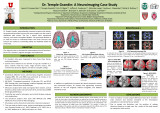 |
Grandin, Temple | Dr. Temple Grandin: A neuroimaging case study | 2011-05-12 | ||
| 16 |
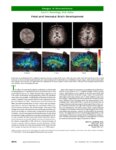 |
Gerig, Guido | Images in neuroscience: Fetal and Neonatal Brain Development | In the top row of longitudinal T1-weighted magnetic resonance images of the same child (and same scale), note the dramatic increase in total brain size as well as in white matter intensity over early development. In the bottom row of diffusion tensor images, white matter tractography of a neonate, o... | 2006-01-01 | |
| 17 |
 |
Tasdizen, Tolga | Long range axon tracing with NeuroTracker | 2012 | ||
| 18 |
 |
CMI Innovation Program flyer: An intellectual property forum: what every faculty member needs to know about patenting and protecting their great idea | CMI Innovation Program Flyer, March 14, 2013. | 2013-03-14 | ||
| 19 |
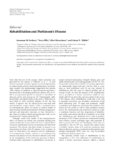 |
Dibble, Leland E. | Rehabilitation and parkinsons disease | Gammon M. Earhart et al. This is an open access article distributed under the Creative Commons Attribution License, which permits unrestricted use, distribution, and reproduction in any medium, provided the original work is properly cited. | 2012-01-01 | |
| 20 |
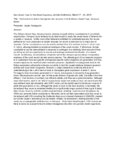 |
Yamaguchi, Ayako | Viral vectors to deliver trasngenes into neurons of adult African clawed frogs, Xenopus laevis | The African clawed frog, Xenopus laevis, produce sexually distinct vocalizations to coordinate reproduction. Xenopus vocal behavior is an ideal model to study the neural basis of behavior for a variety of reasons. Unlike most other behaviors exhibited by vertebrate species, the neural pathways for v... | VSV; viral vector; amphibians | 2019 |
| 21 |
 |
Horch, Kenneth W. | Differential activation of nerve fibers with magnetic stimulation in humans | Earlier observations in our lab had indicated that large, time-varying magnetic fields could elicit action potentials that travel in only one direction in at least some of the myelinated axons in peripheral nerves. The objective of this study was to collect quantitative evidence for magnetically in... | Magnetic stimulation; Peripheral nerve; Electromyographic potential; Somatosensory potential | 2006 |
| 22 |
 |
Tasdizen, Tolga | Long range digital neural circuit reconstruction | 2012 | ||
| 23 |
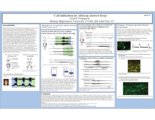 |
Yamaguchi, Ayako | Call initiation in African clawed frogs | Society for Neuroscience Meeting 2016 | vocalizations; Xenopus laevis | 2016 |
| 24 |
 |
Kesner, Raymond P. | The role of GABA-ergic interneurons in CA1 and dentate gyrus for sequence learning | The hippocampus (HPP) is widely accepted as a structure that supports spatial memory. Current interest is focused on temporal processing for sequences of events. It has been demonstrated that HPP lesions disrupt acquisition of a spatial temporal sequence in an 8-arm maze (DeCoteau & Kesner, 2000).... | Hippocampus, learning, memory, interneuron, CA1, dentate gyrus, sequence | 2010 |
| 25 |
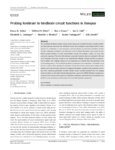 |
Kelley, Darcy B.; Elliott, Taffeta M.; Evans, Ben J.; Evans, Ben J.; Hall, Ian C.; Rhodes, Heather J.; Yamaguchi, Ayako; Zornik, Erik | Probing forebrain to hindbrain circuit functions in Xenopus | The vertebrate hindbrain includes neural circuits that govern essential functions including breathing, blood pressure and heart rate. Hindbrain circuits also participate in generating rhythmic motor patterns for vocalization. In most tetrapods, sound production is powered by expiration and the circu... | fictive respiration; vocalization; pattern generation | 2016 |
